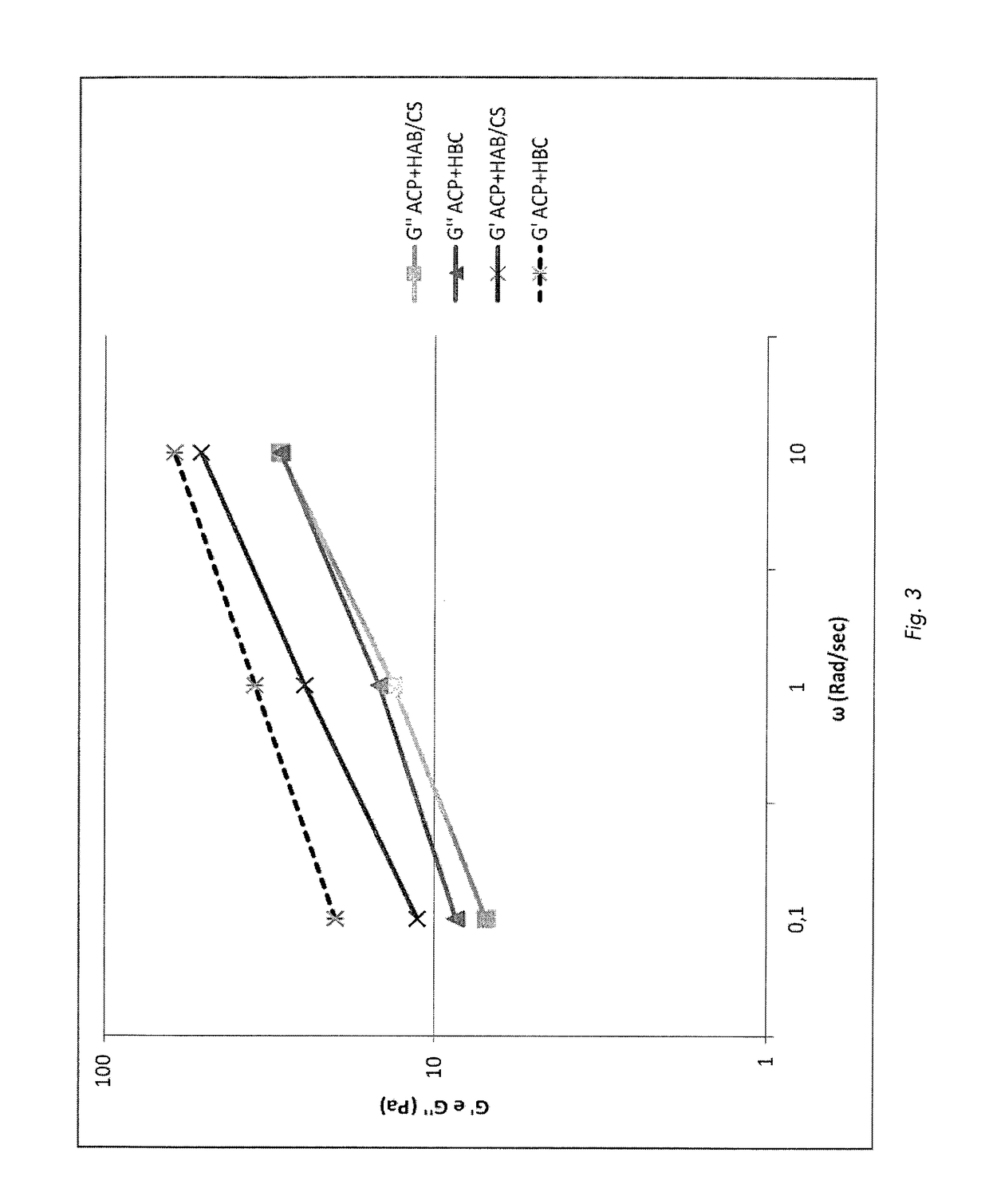Pharmaceutical formulations comprising chondroitin sulfate and hyaluronic acid derivatives
a technology of chondroitin sulfate and hyaluronic acid, which is applied in the field of pharmaceutical formulations, can solve the problems of slow but progressive degradation process, matrix degradation outperforms synthesis, and the synovial fluid of oa joints cannot efficiently protect synovial tissue and articular cartilag
- Summary
- Abstract
- Description
- Claims
- Application Information
AI Technical Summary
Benefits of technology
Problems solved by technology
Method used
Image
Examples
example 1
Composition HAS1 / CS: 1:4
[0072]For this experiment, it was used HAS 1 prepared as per EP 702699 by using a starting HA (in particular its salt with tetrabutylammonium) with a weight average MW comprised between 150-300 KD.
[0073]20 g HAS1 was solubilized in 1 L aqueous buffer formed by monobasic sodium phosphate (0.05 g), dibasic sodium phosphate (0.6 g), sodium chloride (8.5 g) with a pH of 7.4. 80 g CS (Seikagaku Kogyo, Tokyo) having a MW of 50-60 KD was added thereto, the mixture was subjected to mechanical stirring at 40° C. for 1 hr until the complete and homogeneous solubilization of the two components.
[0074]The mixture was cooled to room temperature and then its moduli were determined by using a Thermo Haake Mars II Rheometer at 20° C.
[0075]The values were measured in Pa from 0.01 to 100 rad / sec, at fixed strain values of 10%. All the samples were processed with the Haake Rheowin Job Manager 4.0 software. Results: FIG. 1 shows how the viscous modulus G″ of HAS1 / CS has, at all t...
example 2
Composition HYADD® / CS: 1:1
[0076]For this experiment, it was used HA hexadecylamide (HYADD) with an average degree of amidation of 5%, prepared as per EP 1095064 by using a starting HA with a weight average MW comprised between 500 and 750 KD.
[0077]8 g HYADD was solubilized in 1 L aqueous buffer made from monobasic sodium phosphate (0.11 g), bibasic sodium phosphate (0.45 g), sodium chloride (8.5 g) with a pH of 7.0. 8 g CS (Seikagaku Kogyo, Tokyo) having a MW of 50-60 KD was added thereto, the mixture was subjected to mechanical stirring at 60° C. for 10-12 hrs until the complete and homogeneous solubilization of the two components.
[0078]The mixture was cooled to room temperature and then its moduli were determined by using a Thermo Haake Mars II Rheometer at 20° C.
[0079]The values were measured in Pa from 0.01 to 100 rad / sec, at fixed strain values of 10%.
[0080]All the samples were processed with the Haake Rheowin Job Manager 4.0 software.
[0081]Results:
[0082]FIG. 2 shows how the el...
example 3
Composition ACP®+HBC / CS: 1:1
[0083]For this experiment, it was used the ACP+HBC derivative prepared as per Example 12 in WO2011 / 023355, to obtain 1 L gel containing 25 g ACP+HBC. 25 g CS (Seikagaku Kogyo, Tokyo) having a MW of 50-60 KD was added, the mixture was subjected to mechanical stirring at 40° C. for 1 hr until the complete and homogeneous solubilization of the two components.
[0084]The mixture was cooled to room temperature and then its moduli were determined by using a Thermo Haake Mars II Rheometer at 20° C.
[0085]The values were measured in Pa from 0.01 to 100 rad / sec, at fixed strain values of 10%.
[0086]All the samples were processed with the Haake Rheowin Job Manager 4.0 software.
[0087]Results:
[0088]FIG. 3 shows how also the elastic modulus G′ of this novel composition significantly decreases while its viscous modulus G″ remains substantially unchanged.
PUM
| Property | Measurement | Unit |
|---|---|---|
| MW | aaaaa | aaaaa |
| MW | aaaaa | aaaaa |
| MW | aaaaa | aaaaa |
Abstract
Description
Claims
Application Information
 Login to View More
Login to View More - R&D
- Intellectual Property
- Life Sciences
- Materials
- Tech Scout
- Unparalleled Data Quality
- Higher Quality Content
- 60% Fewer Hallucinations
Browse by: Latest US Patents, China's latest patents, Technical Efficacy Thesaurus, Application Domain, Technology Topic, Popular Technical Reports.
© 2025 PatSnap. All rights reserved.Legal|Privacy policy|Modern Slavery Act Transparency Statement|Sitemap|About US| Contact US: help@patsnap.com



